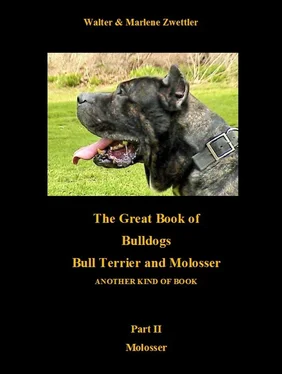CONTENT
HISTORY AND ORIGIN OF THE MOLOSSER BREEDS
ILLYRIAN SHEPHERD (ILLYRIAN MASTIFF/SARPLANINAC)
KANGAL
ARMENIAN SHEPHERD (GAMPR/GAMPYR)
CENTRAL ASIAN OVCHARKA
MASTIFF
BULLMASTIFF
BULLENBEISSER
GREAT DANE
BOXER
BROHOLMER (FREDERIK VII MASTIFF, DANISH MASTIFF)
BOERBOEL
DOGUE DE BORDEAUX
ST. BERNARD
GREAT SWISS MOUNTAIN DOG
MASTINO NAPOLETANO (MASTINO ITALIANO / NEAPOLITAN MASTIFF)
CANE CORSO
FILA BRASILEIRO
Sleuth-Hound
Rafeiro do Alentejo
Cao de Fila da Terceira (Fila Terceirense, Rabo Torto)
CUBAN MASTIFF / CUBAN BLOODHOUND
GRAN MASTINO DE BORINQUEN
BANDOG (AMERICAN MASTIFF)
OLDE BRAZILIAN BANDOGGE
MASTIN ESPANOL (SPANISH MASTIFF)
CA DE BOU (PERRO DE PRESA MALLORQUIN)
ALANO ESPANOL
Perro de Toro Espanol (Spanish Bulldog)
PERRO DE PRESA CANARIO (CANARY DOG / DOGO CANARIO)
AKITA INU
TOSA INU
SUMMARY
PHOTOS
LITERATURE
HISTORY AND ORIGIN OF THE MOLOSSER BREEDS
Aristotle (384 – 322 B. C.) praises the Molossers:
“In Molossis also a dog breed, serving as protector of the herds, distinguishes by its size and tremendous courage towards wild beast and above all other dogs.”
t is said, the name Molosser derives from the tribe of the Molossi (respectively Molosser), that lived in Epirus in the northwest of Greece. The antique Epirus bordered on Thessaly and Macedonia in the east and in the north it extended to the south of today’s Albania.
The Molossi kept guardian and war dogs, being famous for their courage and ferocity and became known as “Canis Molossis” (= dog of the Molossi). Generally it is supposed that these Molosser dogs were the early, ferocious forerunners of the Mastiff and direct descendants of the Tibetan Mastiffs.
What we know for sure is that dogs accompanied men on their tours and traders and warriors took them over the great routes, still having existed in prehistoric time. However, one doesn’t know the then routes of human migration precisely, the same being valid for the dogs. Some cynologists think that the ancestors of these dogs would to be found even farer in the east, in an area, where the ancestors of the Tibetan Mastiff have been found.
Generally Mesopotamia is kept for the cradle of civilization, where the Sumerians have lived 3000 B.C. The Sumerians have been great trading people. They even came to the Indus and further, also to the Nile on land and on ship. However, they bred sheep, goats and pigs too, for which they most likely needed guardian and herding dogs. They were huge, powerful dogs with pendulous ears, which were used as fighting dogs in martial fights and for amusement towards bears, lions and donkeys. About 1000 B. C. so called “Indian dogs” or Tibetan dogs appeared. Usually they were blends from original Tibetan and native big dog strains from the Middle East. They were regarded as very dangerous with and hardly to controlling fury and were used as war dogs. About 500 B. C. Sumerians, Assyrians and Persians improved this “Tibetan dog” with aggressive native dogs. From Mesopotamia dogs would have been taken west to Egypt, the Turkey, Libya, Greece, Rome, Syracuse, Carthage and Spain.
The Greeks were the first to write manuals about dogs; a practice which was continued by the Romans. Aristotle was the first to discuss anatomy and physiology of the dog. In 350 B. C. he listed the “most useful” breeds among them the Molossers.
It is said that the Phoenicians, traveling to Italy, Spain, France and even Cornwall, where they bought tin, would have taken these dogs with them, eventually to sell them together with sheep and goats to the herdsmen of those areas. Many, still today available sources refer to the early differentiation, which had developed, namely the white, long muzzled, slimmer “herding“ dog and the darker heavier dog, which was used for protection and for war. About 60 A.D. Columella , a Roman writer, describes in his work “De Re Rustica” two types of dogs, namely guard and herding dogs for the herds and their owner. The guard dog was big, strongly built, with broad jaws and often black. This color was more intimidating and blended in with the dark. However, the herding dog was less heavy built than the guard dog, as he had to be able to run fast enough to run the wolves off. They used to be white, to make it distinguishable to the shepherd from a raiding wolf and to be better seen in the dark. These herding dogs guarded the herds; they were big, ferocious dogs, being big enough to keep away wolves, raiding dogs, big game and thieves.
As soon as these molossoid dogs had come to the Roman Empire, they already were bred for special purposes. One could say that this was the first step to the development of “breeds” within one species. The Romans developed a breed being very similar to today’s Sennenhund or Swiss Mountain Dog. In fact, there were no prehistoric Swiss Mastiffs or doggen prior to the last century B. C. The Romans took their mastiffs into then Gaul. Their mastiffs guarded the mountain passes where a few hundred years later the St. Bernard would be found.
These early breeds also contributed to French breeds like the Dogue de Bordeaux. Also to the south, in Italy, molossoid dogs developed which can be regarded as the ancestors of today’s Mastino Napoletano.
In Spain the Spanish Mastiff developed, to north, in Belgium, a tracker, the St. Hubert, developed from those fierce hunting dogs of prehistoric time, being the ancestor of today’s Bloodhound.
In the Alps, these early mastiffs are thought to have been adopted by the Germanic tribes and then to have traveled with the Angels and Saxons to Britain. These early mastiffs originally were guard dogs, but because of their courage and their ferocity towards predators they also were suited for hunting bear and wolf, which existed in Britain at the time of the Saxons. By the Middle Ages some mastiffs had become butcher’s dogs and then were bred for bull baiting and dog fighting. With each change in role, came physical changes to enable the dog to better perform in his new role.
In the meantime, throughout the mountainous regions and high plains stretching from Central Asia through Asia Minor, Eastern Europe to the Pyrenees, the shepherds continued to use their white herding dogs as the protectors of their herds as already described in the time before Christ. The descendants of these long haired, white dogs still exist today, like the Akbash in the Turkey, the Tatra of Poland, and the Kuvasz in Hungary or the Maremmano in Italy. The dark colored herding dogs you still will find in certain regions as for example the Illyrian Shepherd Dog on the Balkan, the Kangal in Eastern Turkey or the Middle Asian Ovcharka.
Mastiff blood with an introduction of the northern Spitz is thought to be the probable origin of the rough-coated Ovcharka in Russia. This northern “spitz” type dog is also considered to be the ancestor of many of the Oriental breeds, some of which were crossed with Mastiff breeds to create the Tosa Inu, the famous fighting dog of Japan, and the Dosa in Korea.
Also in South America own molossoid breeds developed from dogs, which the conquistadors had brought with them, as for example Spanish Mastiffs, dogs of bulldog type and Bandog type. One breed originating from these dogs for example is the Fila Brasileiro, a breed special suited for the South American ranches and plantations.
ILLYRIAN SHEPHERD (ILLYRIAN MASTIFF/SARPLANINAC)
n the ancient world the Illyrians lived northwest from Greece, in the regions of Epirus, Albania, Montenegro, Bosnia, Herzegovina and South and Central Dalmatia. Greek and Roman writers described these countries all together as Elyria. The Greek historian Herodotus used the term Illyrians for the first time. In 219 B. C. the region mainly came into Roman control and finally was integrated in the Empire under Caesar.
Читать дальше












